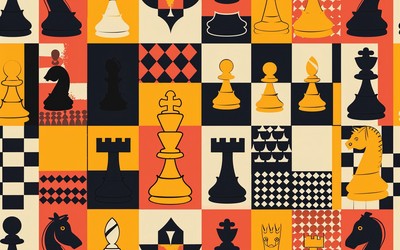
Stanley Sherman/Getty Images
No Nonsense Nona
Revisiting an uncompromising world championThe Queen’s Gambit got a lot of things right, but it made a big misstep when it came to Nona Gaprindashvili, having a commentator say,“she's the female world champion and has never faced men.” The real Nona Gaprindashvili — grandmaster and women’s world champion from 1962 to 1978 — did play men. Or, to be more accurate, does. At 81 years old, Gaprindashvili continues to compete in open events. She took issue with Netflix’s inaccurate portrayal and filed a lawsuit, which was settled out of court. In a way, it’s unfortunate that the wider world’s introduction to this chess legend came in the form of this somewhat incidental legal affair. In another sense, it’s the perfect introduction: Nona doesn’t take shit from anyone.
I recently learned about Gaprindashvili from two exciting new sources, the book Chess Queens by Jennifer Shahade and the Chessable course Queens of the Chess Board by Luciana Morales and Bryan Tillis.
Nona Gaprindashvili was born in 1941 in Zugdidi, a small town in Georgia. Georgia is a small country on the Black Sea. For women in Georgia, chess had traditionally been a pastime enjoyed in the home, but Nona was discovered by a chess coach and moved to the capital where she began serious training. In 1962 she claimed the women’s world championship by defeating Russian champion Elizaveta Bykova 9-2, which has to be one of the most lopsided world championships of any kind in chess history. Gaprindashvili held the world championship for 16 years, finally relinquishing it to Maia Chiburdanidze, one of the next generation of Georgian women she helped inspire.
At the same time (despite what they said in The Queen’s Gambit) she continued to play against men. Her biggest success in an open field came in the Lone Pine tournament in California in 1977, where she tied for first, beating four grandmasters. According to Shahade, the tournament bulletin wrote that she was “constructed more like a bricklayer than a woman.” Pictures of Gaprindashvili do not look bricklayer-ish to me, but even if she did, so what? The bulletin comment reflects a tendency to see Gaprindashvili as a paradox: feminine but strong, small but powerful, reserved but aggressive. In reality there is nothing especially contradictory about any of these qualities, but they did make it harder to pigeonhole her into existing stereotypes.
What has sometimes been lost in all this is Gaprindashvili’s chess itself, which is a shame, because she’s a spectacularly entertaining player. From the very beginning she’s been uncompromising in her aggression and creativity, bringing to mind the attacking world champion Mikhail Tal.
Here is one of her most spectacular wins, played in the Georgian Championship in 1963 against Alexander Blagidze.




